Have you ever left the city of Moscow on the M4 highway in mid-May? A few kilometers after the MKAD, the lawns along the road are painted in blue-violet tones. So unpretentious flowers bloom, raising their heads high. This is perennial lupine, planting and care, photos, diseases and pests, we will talk about it below.
Content
- 1 Description
- 2 Chemical composition
- 3 Seed Planting Methods
- 4 Landing in the fall in the ground
- 5 Spring planting
- 6 Planting seeds for seedlings
- 7 An unusual way to grow lupine
- 8 Lupine Care
- 9 Seed collection
- 10 Diseases and Pests
- 11 Types of Lupins
- 12 Varieties for coloring inflorescences
- 13 Lupine and other plants
- 14 The benefits of lupine
- 15 Interesting about Lupine
Description
Lupine hails from the countries of the Mediterranean, Africa and South America. It can grow not only on the plain, but almost at a five-kilometer height, as well as in the desert.
The name lupine is translated from the Latin language as a wolf, and in Russian it is sometimes called the “wolfberry”. It belongs to the legume family. It is grassy and shrubbery.
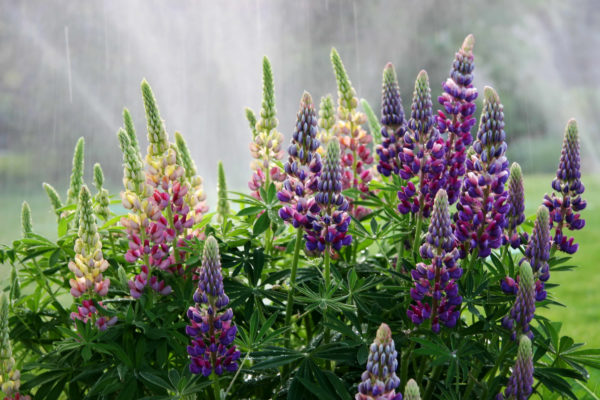
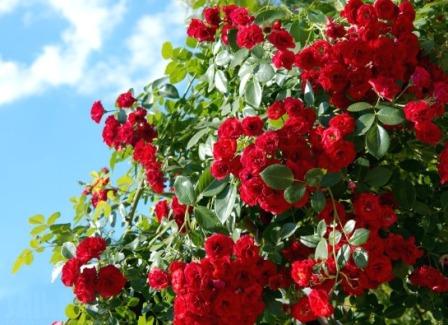 You may be interested in:
You may be interested in:It has long roots extending deeper than 2 m.
Like other beans, it can absorb and process nitrogen with the help of processes on the roots, saturating the soil with it.
The bush is erect, leaves are palmate green.
Plant height depends on the variety.
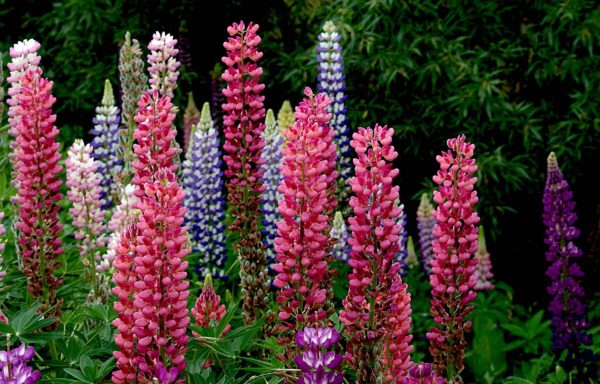
Inflorescences are large, with many flowers of various colors. Some species are bicolor or gradually changing from one color to another. The flowering time of perennial lupine is about a month.
Seeds are hidden in bean boxes.
Chemical composition
Lupine seeds contain protein (42.1%), fat (8.6%), alkaloids (lupanin - up to 3.5%, as well as lupinin, luranin, hydroxylupanine, angustifolin), carotene, flavonoids, sugars, starch, fiber , ash, calcium, nitrogen-free extractive substances, etc.In the whole aerial part of the plant, tannins, alkaloids, amino acids (aspartic, glutamine, etc.) and fiber were found.
In the leaves of the plant, up to 2% of the lupanine alkaloid, flavonoids, was found. The chemical composition of lupine root has not been studied.
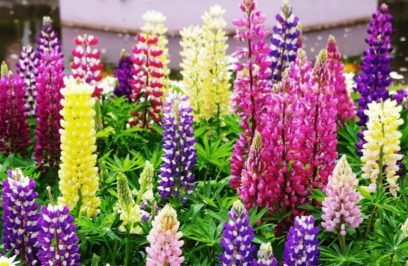
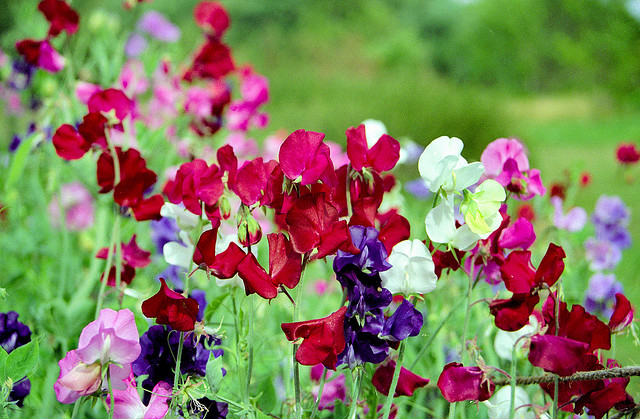 You may be interested in:
You may be interested in:Seed Planting Methods
Lupine perennial responds well to the care of him. Landing and care do not require large skills. Photos with him reflect the magnificence of the flower garden. And from the seeds you can get a great planting material quickly enough.
Lupins can be planted in various ways, depending on what effect and flowering time you want to achieve.
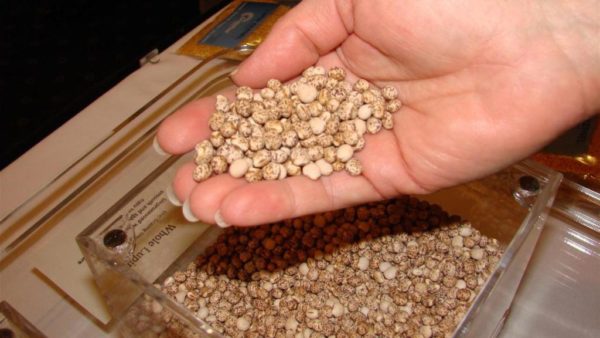
- Autumn in the ground.
- Spring into the soil.
- For seedlings.
The selection of material and soil, as well as the actions during planting, are the same. We will analyze them in more detail when growing seedlings. But there are some features, let's talk about them.
Landing in the fall in the ground
Prepare a place in advance by harvesting weeds, adding fertilizer and good soil.
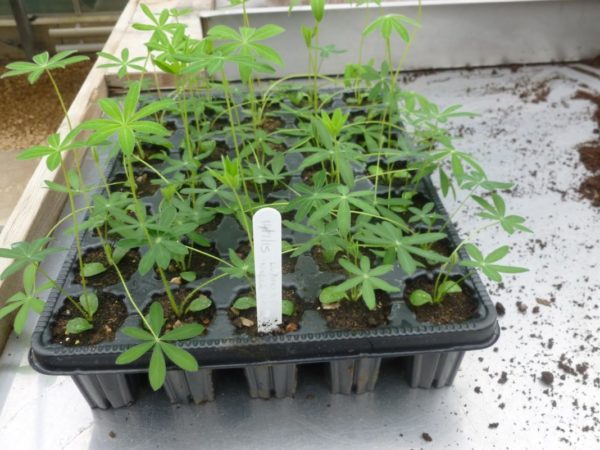
Seeds are scattered on the surface and sprinkled with a layer of peat.
During the winter, they will undergo the necessary processing and will please you with flowering in the first season.
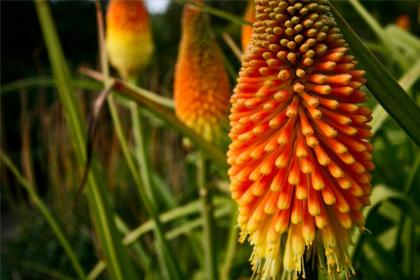 You may be interested in:
You may be interested in:Spring planting
If lupine is planted on a flowerbed in spring, this can be done already in early May. Seeds and plants are not afraid of frosts to -4 degrees.

Unfortunately, in the summer you will receive only green mass, and flowers for the next year.
Planting seeds for seedlings
Lupine perennial improves not only the appearance of the site, but also the soil, so its landing is required, especially on heavy lands. And caring for them turns into pleasure. A photo of growing seedlings can be seen below.

If gardeners dream of getting lupine in the first year after planting, you can plant the seeds in containers in March or April. Lupine is not very fond of transplanting, so try to pick up the pots in which he will grow before planting in the garden, it is better to plant the seeds in peat containers. Together with them, it must be transplanted.
To land, you must follow these steps:
- Choose containers for landing.
- Processed with a weak solution of manganese.
- Prepare the ground. A drain is placed at the bottom of the pot so that the water does not stagnate.
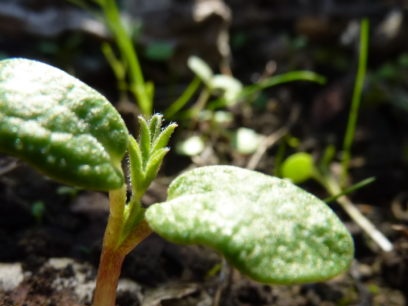
- Soil mix is bought ready, or turf, peat, sand are mixed 2: 2: 1.
- Lupine beans are stratified, left in the freezer for a day, then thrown into boiling water.
- Then soaked for a day in a solution of a biostimulant: zircon, root, to soften the shell seed.
- Then planted in pots prepared in advance.
- Cover with covering material.
- After emergence (about 1-2 weeks), agrotextile is removed.
- If necessary, produce additional illumination.
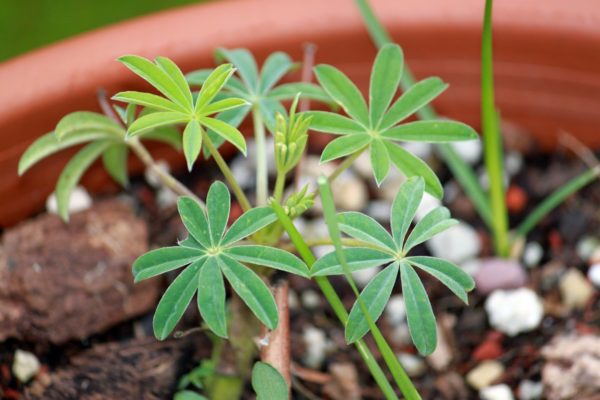
- In mid-May, lupins are transplanted into the ground at a distance of 50 cm from each other. At the bottom of the landing pit, drainage is laid and spilled.
- Add fertilizer. That nitrogen fertilizers are put in small quantities, since the plant is able to pick them up from the soil.
- When planting, they act cautiously, trying to completely remove the plant along with a lump of earth, without damaging the roots.
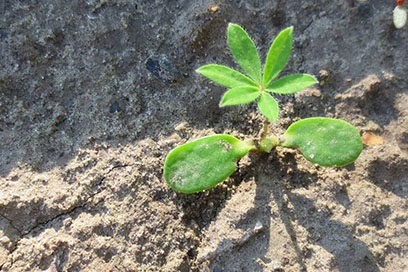
- A lumped lump is put in a hole on the ground level and thrown into the soil, trampled.
- Watering.
- Since most varieties of lupine are tall, the plant is tied up.
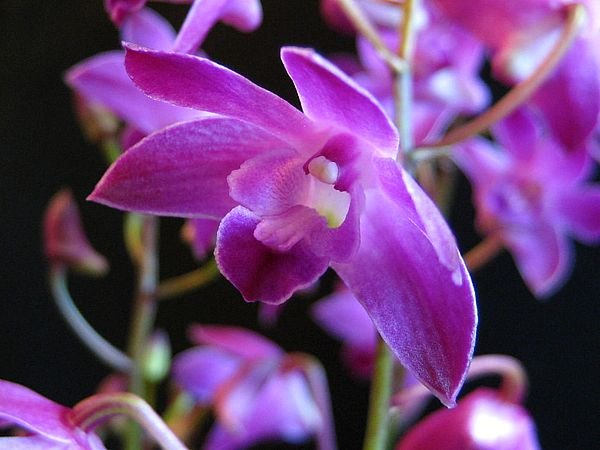 You may be interested in:
You may be interested in:An unusual way to grow lupine
In autumn, you can scatter lupine seeds under the trees. This flower perfectly takes root near the apple tree, cherry, plum and other fruit trees.
After winter, in spring you will see a whole lupine garden. For this, seeds of different colors are best suited. Then you will get colorful and bright flowers in April.
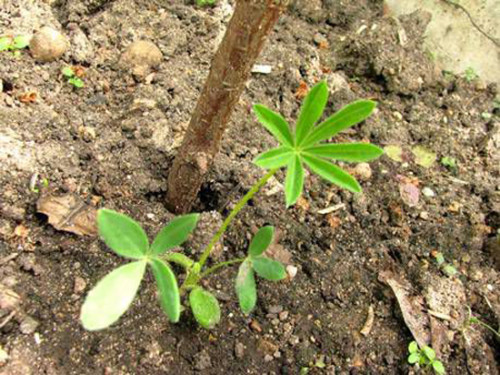
Lupine Care
The plant is not picky, but still requires a little care:
- Watering is uniform, not more than 1 time per week, if it does not rain. Watch out for them and drought. On sunny, hot days, watered after two days.
- Mineral dressing and spraying on the leaves is done once every 4 weeks, 14 days after the mineral is fed organic, for example, diluted bird flight.
- Weeding. Since the root system of the lupine is pivotal, it is necessary to periodically loosen the soil and release it from weeds, to a depth of 5-7 cm.
- The voids between the flowers are filled with mulch. Use crushed wood materials and stone as protection against cracking mail, evaporation of moisture.
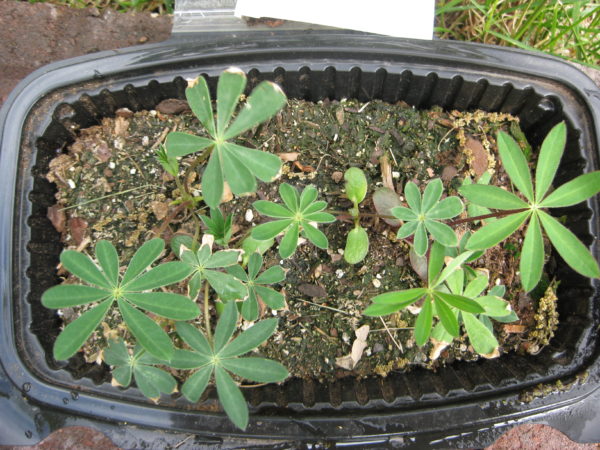
Seed collection
Flower seeds are collected in a bean, break off quite easily. If you do not pluck during, the box will open and the small seeds inside will scatter throughout the site. Which is bad, the next year will have to fight with lupine.
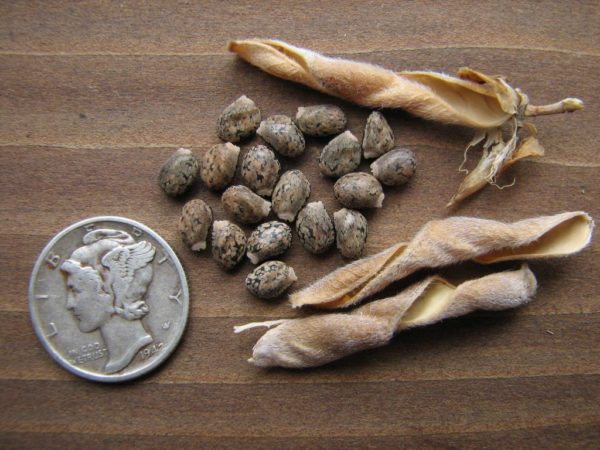
Diseases and Pests
Lupine can be affected by diseases and pests. The most common are:
- Rust.It manifests itself with convex spots of orange color, is removed by fungicides or onion and garlic infusion.
- Ring spotting forms red or brown spots. They are treated with copper-containing preparations, for example, Bordeaux liquid or copper sulfate.
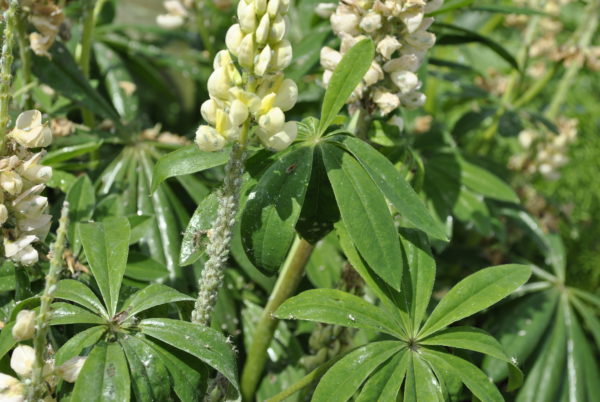
- The mosaic forms green patterns lighter than the entire leaf plate; soil disinfection with appropriate substances is necessary.
- Various types of rot, both stem and root, lead to the death of lupine. If you notice immediately, you can shed against the fungus.
- Among pests, aphids that feed on plant tops, weevils and sprout flies can often be seen. The plant is well watered from a hose, knocking down insects, then it is treated with a soapy solution from laundry soap and insecticidal preparations.
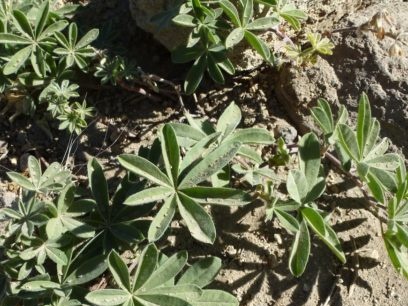
Types of Lupins
Since lupine grows quite on a vast territory from Europe to America, it has a lot of species, in the table some of them.
| view | description | leaves | Inflorescences and flowers | bloom |
| Multi-sheeted | Erect stems up to 1 m | Covered from below with a pile. | 30-35 cm. | June |
| Narrow-leaved (blue) | Straight, 150 cm, bare trunk. | Rare, pubescent. | Tall with flowers that have blue spots. | May June |
| White | 140 cm. | Emerald, dissected, along the edge of small villi. | Long, spiraling flowers. | June |
| Russell | Have a pleasant aroma, powerful bush | Dark, dissected plates. | Huge up to 45 cm, similar to puffed sails. | The end of May |
| Dwarf | Low stems, often sold as a mixture. | Green, palmate | Variegated, racemose | The beginning of June |
| Yellow | 100 cm, with a fluff, few leaves, emits a smell of reseda. | Long petioles, at least 5 fingers | Peduncle up to 20 cm, golden color. | June |
Varieties for coloring inflorescences
Over many years of history, a huge number of varieties of perennial lupine have been bred, each species has more than a dozen of them. Planting and caring for them is practically no different, but you can create completely different flower beds.
| Flower color | varieties |
| White | Burg Fraulen, Albus, Desniansky, Degas, Gama, Silver |
| Yellow | Yellow flame |
| Pink with burgundy and without |
Hartwig King, Stossfrau, Edelknabbe, Princess Julianne, Roseus |
| Multicolor | Fireworks, Lulu |
| Orange | Apricot |
| Red | Karminius |
| Blue | Castellan |
| Violet | Rubinkenig |
Lupine and other plants
Due to its growth and huge inflorescences, the plant looks great both in group plantings and as a loner. Lupine perennial is perfectly combined with other plantings, the care of which is close to the conditions for the growth of a wolf flower. The photos with which to plant this flower are diverse, as well as the type of flower beds.
If lupins are planted in the background of the mixborder, then plants below are picked up, but capable of closing bare stems, for example, any kind of daisy, perennial asters, hosts, low coniferous shrubs, cotoneaster horizontal, asters and chrysanthemums.

The benefits of lupine
In addition to decorative properties, lupine also has a number of useful properties:
- The plant is a wonderful green manure. In addition to decorative, there are feed varieties. But both are capable of improving the soil, like many legumes. They absorb nitrogen-containing substances from the soil and give back the pure nitrogen necessary for plant nutrition. The green mass of young flowers is often cut off and the land is plowed with them.
- Some people use lupine stems in paper making.
- The seeds and the beans themselves look great in various crafts.
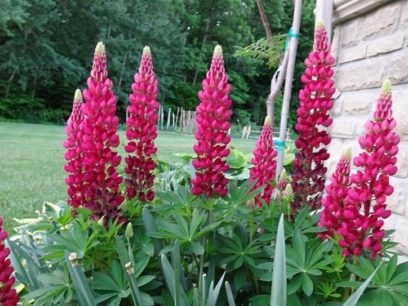
- The pharmaceutical industry does not do without this plant. Squeezed from it is used in medical plasters.
- And it is added to cosmetics and soap because of its antioxidant and anti-aging properties.
- On some marine and river farms, lupine is added to fish food. Also, fur farmers add seeds to rabbits.
- Beans are used in cooking, they contain more than 300 kilocalories per 100 g.
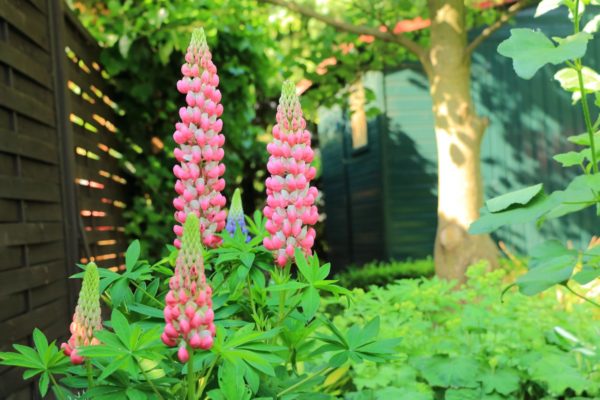
Interesting about Lupine
In addition to all of the above, you can talk about this flower endlessly:
- There are more than 200 species of lupine.
- Long-term care is not required for lupine on Lake Tikalo in New Zealand, and no landing is needed. Here they grow self-seeding and in the photo very beautiful landscapes are obtained.
- Flowers can be planted to scare away mice, as well as to lay out at home.
- Lupine is a symbol of Texas State USA.
- Contains more than 60% protein.
- An arctic lupine was found with a seed age of about 15,000 years.

Lupine, one of the first few flowers to bloom in May, will surely delight gardeners with its flowering with proper care. And how to do this, look at the video.




 Sow in the ground, without seedlings: 10 beautiful and unpretentious flowers
Sow in the ground, without seedlings: 10 beautiful and unpretentious flowers Platicodon planting and outdoor care
Platicodon planting and outdoor care Hosta - planting and care in the open ground in the Urals
Hosta - planting and care in the open ground in the Urals Oleander - care and growing at home
Oleander - care and growing at home